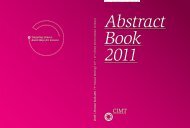Abstract Book 2010 - CIMT Annual Meeting
Abstract Book 2010 - CIMT Annual Meeting
Abstract Book 2010 - CIMT Annual Meeting
You also want an ePaper? Increase the reach of your titles
YUMPU automatically turns print PDFs into web optimized ePapers that Google loves.
028 Laske | Immune monitoring<br />
T-cell immunomonitoring in patients with renal cell carcinoma<br />
after multi-peptide vaccination<br />
Karoline Laske 1 , Annemarie Dröge 1 , Susan Feyerabend 2 , Jörg Hennenlotter 2 , Jens Bedke 2 , Patricia<br />
Hrstic 1 , Stefan Stevanovic 1 , Arnulf Stenzl 2 , Cécile Gouttefangeas 1 , Hans-Georg Rammensee 1<br />
1 Institute for Cell Biology, Department of Immunology, Eberhard Karls University Tuebingen,<br />
Auf der Morgenstelle 15, 72076 Tuebingen, Germany<br />
2 Department of Urology, Eberhard Karls University Tuebingen, Hoppe-Seyler-Str. 3, 72076 Tuebingen,<br />
Germany<br />
In this clinical trial, patients with advanced or<br />
metastatic renal cell carcinoma after complete resection<br />
receive a multi-peptide cocktail containing<br />
HLA-class I and II binding peptides. The vaccine is<br />
applied either intradermally with GM-CSF as adjuvant<br />
or subcutaneously in Montanide ISA52 at<br />
18 vaccination time points over 12 months or until<br />
progression. Computer tomography imaging is performed<br />
to evaluate progression-free survival every<br />
3 months. HLA-A*02 positive or negative patients<br />
receive an individual peptide cocktail containing<br />
between 3 and 12 HLA-class I binding peptides.<br />
These peptides are known epitopes or ligands<br />
derived from selected tumor-associated antigens.<br />
Furthermore, the peptide cocktail for HLA-A*02 positive<br />
patients contains one peptide (from the influenza<br />
virus) as recall control and one peptide (from<br />
HBV) as priming control for the vaccination.<br />
Additionally, 3 to 4 HLA-class II binding peptides<br />
are included for CD4+ T-cell stimulation. Until<br />
now, 17/40 patients have been recruited and T-cell<br />
monitoring was performed for 9 patients. Blood<br />
was collected at each vaccination time point, serum<br />
and peripheral blood mononuclear cells (PBMCs)<br />
were isolated and frozen. For T-cell monitoring,<br />
PBMCs from different time points were thawed and<br />
stimulated with the individual peptide cocktail for<br />
12 days. Detection of specific T-cells was performed<br />
by IFN-gamma Elispot, tetramer staining (for<br />
HLA-A*02 positive patients) and intracellular cytokine<br />
staining. So far, all 7 monitored HLA-A*02<br />
positive patients developed a strong CD4+ T-cell<br />
response against 2 of the 4 HLAclass II binding<br />
epitopes (derived from carbonic anhydrase 9 and<br />
cyclin-D1 protein) which were detected by Elispot<br />
and further characterized by intracellular cytokine<br />
staining. We could detect a CD8+ T-cell response<br />
in 4 of 7 HLA-A*02 positive patients. The most frequently<br />
recognized peptides are from the proteins<br />
cyclin-D1 and guanylate cyclase 1.<br />
69



